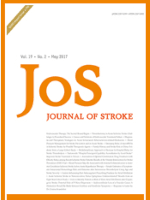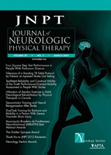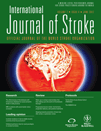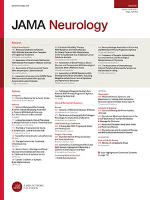
Journal of Stroke
Scope & Guideline
Innovating Clinical Practices in Stroke Management
Introduction
Aims and Scopes
- Stroke Epidemiology and Risk Factors:
Research focusing on the incidence, prevalence, and risk factors associated with stroke, including demographic studies and the impact of comorbidities. - Acute Stroke Management:
Studies related to the acute management of stroke, including thrombolysis, thrombectomy, and the role of various treatment protocols and guidelines. - Rehabilitation and Recovery:
Exploration of rehabilitation strategies post-stroke, including physical therapy, occupational therapy, and the use of technology in enhancing recovery. - Neurovascular Imaging and Biomarkers:
Research into neuroimaging techniques and biomarkers for stroke diagnosis, prognosis, and treatment efficacy. - Patient Outcomes and Quality of Life:
Investigations into the long-term outcomes of stroke patients, including quality of life assessments and the impact of psychological factors. - Innovative Therapies and Interventions:
Evaluation of new therapies and interventions, including pharmacological treatments, lifestyle modifications, and technological solutions in stroke care. - Health Systems and Policy:
Studies addressing health systems, policy implications, and disparities in stroke care, particularly in low-resource settings.
Trending and Emerging
- Telemedicine and Remote Care:
The COVID-19 pandemic has accelerated the integration of telemedicine in stroke care, leading to increased research on remote assessments and virtual rehabilitation. - Artificial Intelligence and Machine Learning:
There is a growing trend towards the application of AI and machine learning in stroke diagnosis, treatment planning, and outcome prediction, reflecting advancements in technology. - Patient Engagement and Experience:
Research focusing on the experiences and perspectives of stroke survivors and caregivers is gaining momentum, emphasizing the importance of patient-centered care. - Multidisciplinary Approaches to Stroke Rehabilitation:
Emerging studies highlight the effectiveness of multidisciplinary strategies in stroke rehabilitation, indicating a shift towards comprehensive care models. - Longitudinal Studies on Cognitive Outcomes:
Increasing attention is being paid to the long-term cognitive outcomes following stroke, including the assessment of cognitive decline and rehabilitation effectiveness. - Health Disparities and Social Determinants of Health:
An increasing focus on health disparities, particularly how socioeconomic factors influence stroke outcomes and access to care, is becoming more prevalent.
Declining or Waning
- Traditional Risk Factor Studies:
Research focusing solely on traditional risk factors for stroke (e.g., hypertension, diabetes) may be waning as new studies increasingly explore multifactorial and systemic approaches. - Single-therapy Focus:
There appears to be a shift away from studies that evaluate the efficacy of single therapies in favor of multi-modal treatment approaches that consider patient-centered care. - Basic Science Studies:
While foundational research is crucial, there is a notable decline in basic science studies presented in the journal, with a stronger emphasis on clinical applications and outcomes.
Similar Journals

Cardiology Journal
Elevating standards in heart health scholarship.Cardiology Journal, published by VIA MEDICA, stands as a prominent resource in the field of cardiology and cardiovascular medicine, with an ISSN of 1897-5593 and an E-ISSN of 1898-018X. Recognized for its Open Access model established since 1994, this journal facilitates widespread dissemination of critical research findings, allowing practitioners and researchers globally to access valuable insights without barriers. Based in Poland, with an address at UL SWIETOKRZYSKA 73, 80-180 GDANSK, it has achieved a respectable Q2 classification in 2023 for both Cardiology and Miscellaneous Medicine categories, reflecting its influence and quality within the scholarly community. With a Scopus ranking placing it at #117 out of 387 in Cardiology, it lies within the 69th percentile, underpinning its commitment to advancing knowledge in cardiovascular health. The journal’s converged years extending from 2006 to 2024 ensure it captures ongoing developments in a rapidly evolving field. As such, the Cardiology Journal serves as an indispensable platform for researchers, professionals, and students dedicated to exploring the frontiers of cardiac science and improving patient care.

Journal of NeuroInterventional Surgery
Pioneering New Pathways in NeuroInterventional Surgery.The Journal of NeuroInterventional Surgery, published by the BMJ Publishing Group, stands at the forefront of advancing knowledge in the fields of neurointerventional procedures, neurology, and surgical techniques. With an impressive impact factor reflective of its high-quality contributions, this journal occupies a prestigious position within the Q1 category across multiple domains: Medicine (miscellaneous), Neurology (clinical), and Surgery, ranking 11th in Medicine Surgery and 47th in Neurology Clinical out of their respective categories per Scopus metrics. Since its inception in 2009, it has provided an essential platform for researchers, clinicians, and students to disseminate innovative findings and engage with groundbreaking developments in neurointerventional practices. As a prominent publication in the United Kingdom, located at British Med Assoc House, it is committed to open communication within the community, fostering collaboration, and setting the stage for future innovations in patient care and outcomes.

International Journal of Chronic Obstructive Pulmonary Disease
Leading the Charge Against Chronic Lung DiseaseThe International Journal of Chronic Obstructive Pulmonary Disease, published by DOVE MEDICAL PRESS LTD, serves as a premier platform for researchers and professionals involved in the study and management of COPD. Established in 2006 and transitioning to an Open Access model in 2009, this journal has quickly gained a reputable standing in various impactful categories, achieving Q1 rankings in Health Policy, Medicine (Miscellaneous), and Public Health, among others. With a focus on disseminating high-quality research, the journal is pivotal for addressing global public health challenges associated with chronic obstructive pulmonary disease. The journal's dedication to open access ensures that vital information reaches a broader audience, fostering advancements in research and clinical practice. By maintaining rigorous peer-review standards and a commitment to the advancement of understanding in COPD, the journal attracts significant contributions from scientists and practitioners worldwide, making it an invaluable resource for ongoing education and research development in this critical area.

Journal of Neurologic Physical Therapy
Advancing Rehabilitation through Neurologic InsightsJournal of Neurologic Physical Therapy, published by Lippincott Williams & Wilkins, stands as a premier resource in the field of physical therapy with a specific focus on neurology. With an ISSN of 1557-0576 and an E-ISSN of 1557-0584, this journal serves as a vital platform for researchers, practitioners, and students from 2004 to 2024, illustrating its commitment to advancing knowledge in neurologic rehabilitation. It holds a prestigious Q1 ranking in categories such as Physical Therapy, Sports Therapy, and Rehabilitation and Rehabilitation, alongside Q2 rankings in Geriatrics and Gerontology, Medicine (Miscellaneous), and Neurology (Clinical). With an impact factor that reflects its significance, the journal hosts comprehensive studies and clinical insights that propel practice and innovation in neurologic physical therapy. The content is designed to enhance understanding and skills, making it an indispensable resource for those dedicated to improving patient care and outcomes in this critical area of health.

Stroke-Vascular and Interventional Neurology
Driving excellence in the understanding of cerebrovascular diseases.Stroke-Vascular and Interventional Neurology, published by WILEY, is a leading open-access journal dedicated to advancing the field of neurology with a particular focus on stroke and vascular interventions. Since its inception in 2021 as an open-access journal, it has fostered a collaborative environment for researchers, clinicians, and educators to share innovative findings and clinical practices that address the complexities of cerebrovascular diseases. The journal emphasizes high-quality, peer-reviewed research articles, reviews, and case studies, providing critical insights into cutting-edge therapies and surgical techniques. With an ISSN of 2694-5746, it aims to support the global medical community in improving the diagnosis, treatment, and overall management of stroke patients. Researchers and healthcare professionals benefit from its accessible content, which is vital for fostering comprehensive understanding and evidence-based practices within the realm of interventional neurology.

Acta Epileptologica
Pioneering insights into neurological disorders.Acta Epileptologica is a prominent open-access journal published by SPRINGERNATURE, dedicated to advancing research in the fields of neurology and clinical neurology. With its ISSN 2096-9384 and E-ISSN 2524-4434, this journal has established itself as a key resource for researchers and practitioners worldwide, particularly since its transition to open access in 2019. Based in the United Kingdom, Acta Epileptologica aims to disseminate high-quality research and foster scholarly collaboration, as evidenced by its consistent Q3 ranking in both neurology and clinical neurology categories as of 2023. Although currently positioned in the lower percentiles on Scopus, the journal plays a critical role in exploring emerging trends and novel therapeutic approaches in epilepsy research, making it an essential platform for academics, healthcare professionals, and students deeply invested in the evolving landscape of neurological disorders.

European Stroke Journal
Connecting researchers and clinicians for impactful stroke solutions.The European Stroke Journal, published by SAGE Publications Ltd, is a pivotal resource in the domains of Cardiology and Neurology, reflecting its commitment to advancing knowledge and research in these critical areas of medicine. Since its inception in 2016, this journal has rapidly gained recognition, achieving a prestigious Q1 ranking in both Cardiology and Neurology (clinical) as of 2023, placing it among the top quartile publications in these fields. With a prominent position, ranked 65th and 72nd respectively in Scopus for Cardiology and Neurology, the journal caters to a diverse audience of researchers, clinicians, and students dedicated to improving stroke treatment and prevention strategies. Although it operates under a traditional access model, its impactful publications are essential for anyone involved in stroke research, ensuring they remain at the forefront of scientific developments and clinical practices.

Stroke and Vascular Neurology
Pioneering research for a healthier tomorrow.Stroke and Vascular Neurology is a premier open access journal published by BMJ PUBLISHING GROUP, dedicated to advancing the field of vascular neurology and cardiology. With an ISSN of 2059-8688 and an E-ISSN of 2059-8696, the journal has established itself as a leading platform for disseminating cutting-edge research since its transition to open access in 2016. Based in the United Kingdom, at BRITISH MED ASSOC HOUSE, TAVISTOCK SQUARE, LONDON WC1H 9JR, ENGLAND, the journal's outstanding reputation is reflected in its Q1 rankings in both Cardiology and Cardiovascular Medicine and Neurology (clinical) for 2023, placing it in the top tier of its categories. With Scopus rankings of 28 out of 387 in Cardiology and 30 out of 400 in Neurology (clinical), both within the 92nd percentile, Stroke and Vascular Neurology serves as an essential resource for researchers, clinicians, and students looking to stay at the forefront of advancements in the management and understanding of stroke-related disorders. The journal's commitment to high-quality research contributes significantly to improving patient outcomes and shaping the future of vascular health.

International Journal of Stroke
Transforming Stroke Care with Cutting-Edge ResearchThe International Journal of Stroke, published by SAGE PUBLICATIONS LTD, is a leading peer-reviewed journal dedicated to advancing the field of stroke research and clinical practice. Established with a commitment to disseminating high-quality scholarly articles, this journal has rapidly progressed to achieve a prestigious Q1 ranking in both Neurology and Clinical Neurology categories as of 2023. With a remarkably high Scopus rank of #7 among 192 in Neuroscience and #16 among 400 in Clinical Neurology, it places itself firmly in the top 4% of journals in its field, reflecting its significant impact on the academic and clinical landscape. Although it does not currently offer Open Access options, the journal provides a vital platform for researchers and clinicians alike, focusing on innovative treatments, methodologies, and evolving strategies for stroke prevention and recovery. With a publication scope that spans from 2006 to 2024, the International Journal of Stroke continues to foster knowledge exchange and encourage collaboration, making it an essential resource for anyone involved in neurologic healthcare.

JAMA Neurology
Pioneering Research in the Realm of NeurologyJAMA Neurology is a leading peer-reviewed journal published by the American Medical Association, focused on advancing the understanding and treatment of neurological disorders. With an impressive impact factor and ranked in the 99th percentile among clinical neurology journals, this publication is recognized as Q1 in its category for 2023, highlighting its significance in the field. Since its inception, the journal has provided a platform for high-quality research, clinical trials, and reviews that inform both clinicians and researchers. Operating from its headquarters in Chicago, Illinois, JAMA Neurology offers rich insights into the latest advancements in neurology, featuring articles that span a wide range of topics including neurodegenerative diseases, stroke, epilepsy, and neurocritical care. Researchers and professionals are encouraged to access the journal’s content freely, as it employs open access options to promote the dissemination of critical knowledge. As a critical resource in the field of neurology, JAMA Neurology is essential for anyone involved in this dynamic and rapidly evolving specialty.